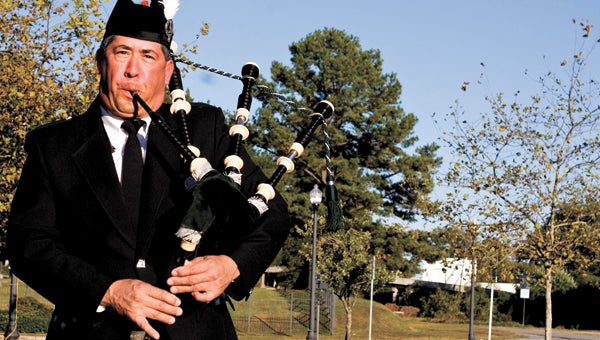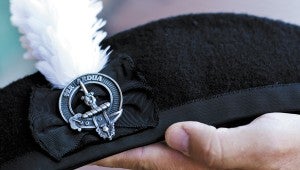Boisterous bagpipes
Published 7:42 pm Tuesday, November 19, 2013

Dr. David Lotz plays his bagpipes at Market Park on an early autumn morning. This set, from the 1940s and made of ivory, set him back about $10,000.
The air that comes out of the musician’s mouth goes down the blowpipe, into the elkhide bag and out of the bass drone and two tenor drones.
The reed vibrates. The musician chooses from nine notes on the chanter and squeezes the air out of the bag. The resonance chambers in the drones give the air the sound of the Scottish isles, the flavor of the highlands, the shape of the Irish fields of green.
The bagpipes, with their many intricacies, require much time, effort and study, not to mention a private tutor who has mastered them, to become even an adequate player.
But the complexities haven’t driven away Dr. David Lotz, an optometrist and family man who still manages to find time to practice his complicated — and expensive — hobby.
He was already no stranger to music, having played the guitar for six years and the saxophone for eight years, when he fell in with a pipe and drum band near his former home in Oregon.
“I love the music,” he said. “I kind of connect with it. It’s like it’s in your blood.”
For Lotz, bagpipes are definitely in the blood. His Scottish-Irish heritage comes through in his dress — just don’t call his plaid kilt a skirt, he says — and through his sound whenever he plays the pipes.
While he comes by his talent honestly, he got into the bagpipes because he knew somebody who played. That’s how it is for most people.
“You almost have to know somebody to get into it,” he said.
While there are tutorial books bagpipers can buy to teach themselves what’s known as “little music” — chants, hymns and the like — what’s known as big music “has to be taught to you by someone who has mastered it,” Lotz said.
The musician also must become master of his own lungs. He must keep a near-constant flow of air into the bag and use his arm to squeeze the bag to keep a constant flow into the drones. Once the musician has started playing, it’s hard to stop, so “grace notes” are used to embellish the music and keep up the constant sound.
Speaking of the sound, not everyone loves it, Lotz said. Even his wife makes him practice in a room above the garage, where he has to use a set of indoor pipes.
“There’s no gray area,” he said. “People love them or they don’t love them — they hate them.”
It’s hard to love the price of the instrument. While there are cheaper sets available, Lotz splurged on his — $10,000 for a 1940s set made with real ivory. Older wood produces a better sound, he says.
Lotz plies his craft at various events around town. Every year, he performs at the Relay For Life and at the wreath-laying ceremony at Albert G. Horton Jr. Memorial Veterans Cemetery.
“Weddings are fun; funerals are very emotional,” he said. “But there’s nothing like the wreath-laying at Horton. I’m a veteran, so you connect with that. It’s a great way to honor those veterans.”
He spent six years in the U.S. Navy.
Lotz says he won’t stop playing the bagpipes anytime soon, unless he loses his lung capacity.
“I love the music,” he said.







